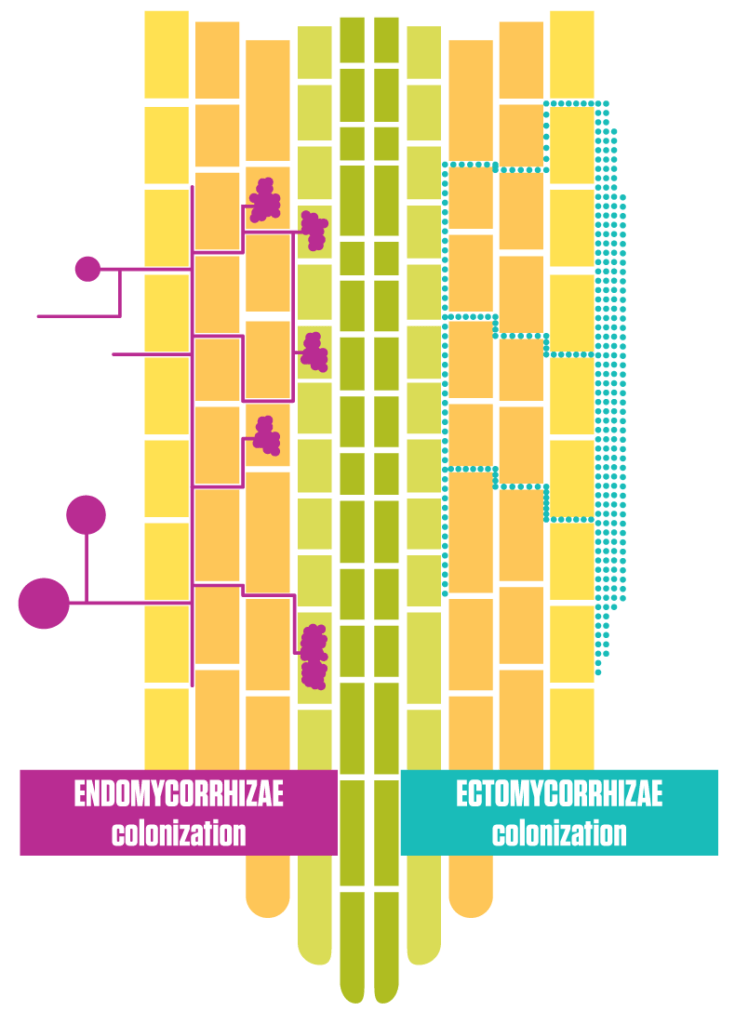How do mycorrhizae help with availability and uptake of essential plant nutrients?
Mycorrhizae help increase the availability of essential plant nutrients in the plant root zone by producing organic acids and enzymes that chelate minerals from an insoluble form, into a form that plants can easily uptake. The small size of mycorrhizal structures when compared to plant roots, allow them to penetrate smaller particles, and colonize spaces in the growing media that roots could otherwise not occupy nor be able to penetrate. Mycorrhizae act as an extension of the plant root network which increases the ability of the plant to take up water and nutrients. Mycorrhizae also produce enzymes and organic acids which can break chemical bonds such as phosphorus, iron, zinc, and calcium, making them more available for the plant.
Ectomycorrhizae vs Endomycorrhizae- What’s the difference and what should we be using?
To better understand Mycorrhizae, it is important to learn more about how each type interacts with the plant. There are two main groups of beneficial mycorrhizae, ectomycorrhizae and endomycorrhizae. Each group has a very specific type of plant that it can interact with. Ectomycorrhizae, from the Latin meaning “outside fungi”, forms a sheath on the outside of the plant root and are most often found on woody plant species such as trees or shrubs. Endomycorrhizae, from the Latin meaning “inside fungi”, will physically grow into the plant root and become an extension of the root itself. The endomycorrhizae members are most often found on herbaceous plants such as flowers, fruits, leafy greens, and grasses. Studies have shown that more than 90% of all plants will form a relationship with endomycorrhizae. In short, this means that for those growing fruits and flowers, endomycorrhizae are a much more desirable inoculant to increase yields, and overall plant health.
How do the properties of growing media (composition material, organic matter %, and pH) affect the colonization of beneficial mycorrhizae?
The composition of the growing media affects the rate and success of mycorrhizae colonization based on percentage of organic matter, pH, temperature, CO2 concentration, and available moisture. Higher percentages of organic matter in the growing media will increase the rate of colonization growth by the mycorrhizae. At a high pH, low pH, or a pH that is outside the range of the host plant, the growth of the mycorrhizae will be decreased. In addition, the lower the temperature of the growing media the slower the mycelium growth, while higher temps increase the rate at which mycorrhizae multiply. There is also a correlation between the concentration of CO2 in the atmosphere of the host plant and the rate of mycorrhizal growth due to the accelerated rates of photosynthesis by plants in enriched CO2 environments (>400 ppm). The amount of free water in the root zone will also effect the growth of mycorrhizae which thrive in moist media.
Why are amino acids so effective when used in combination with beneficial fungi?
Amino acids, such as glycine, are sometimes blended with mycorrhizal inoculants to increase their effectiveness when applied to the plant. All amino acids contain organic nitrogen which acts as a food source for endomycorrhizae, giving them a “starter food” until they can expand their threadlike structures called mycelium, to acquire free nitrogen in the root zone.
Are Endomychorrizae compatible with Trichoderma, Bacillus, and other species of bacteria/fungi, or are certain types overly dominant?
In nature, different types of fungi and bacteria play specific roles and work in synergy with each other, and their environment. While mycorrhizae do have some ability to contribute to disease resistance, they cannot legitimately be classified as biocontrol agents against plant pathogens. This is where other beneficial microbes, such as the fungal species Trichoderma or the bacterium Bacillus, become important to also incorporate. These organisms have a targeted purpose against pathogenic fungi and bacteria and are generally more aggressive than mycorrhizae for disease suppression in the plant root zone.
– Brandon Jewell
Continued in Unlocking your plants’ potential with air ⟶
